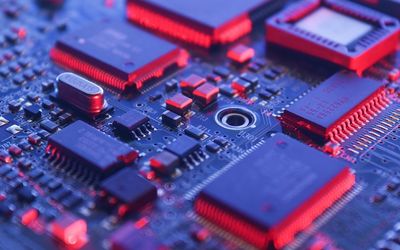Microchip Technology dsPIC33A Curiosity Platform Development Board
dsPIC33A Curiosity Platform Development Board for Embedded Applications
Technical Specifications
| Product Type | dsPIC33A Development Kit |
| On-board programmer | PicKit On-Board (PK-OB 04) |
| GPIO | 120 DIM |
| Capacitive Touchpads | 03 |
| Power Supply | 5V |
| Applications | Embedded Systems, Microcontrollers, robotics, industrial and automotive systems |
Overview
The Microchip Technology dsPIC33A Curiosity Platform Development Board (EV74H48A) showcases the capabilities of the dsPIC33A Digital Signal Controller family. This board requires the EV02G02A Demonstration Board, a 120-pin general-purpose DIM with a dsPIC33A DSC device.
The development board interface includes an RGB LED, a 10K Ohm potentiometer, three push buttons, eight LEDs, and three capacitive touch pads. The board features a PICkit™ On-Board (PKOB4) programmer/debugger circuit for programming and debugging dsPIC33A target devices attached through the DIM connector. The dsPIC33A board supports custom feature expansion with mikroBUS™ and Xplained Pro interfaces.
Integrated On-Board Programmer/Debugger for Rapid Prototyping and Development
The dsPIC33A Curiosity Platform Development Board features an integrated PICkit™ On-Board 4 (PKOB4) programmer/debugger. It’s a powerful tool that reduces hardware complexity allowing for seamless programming, debugging, and verification of the dsPIC33A device.
The PKOB4 is easy to install and operate, as it connects directly to the DIM connector, eliminating the need for external programming equipment. Hence, it provides a convenient and efficient way to develop and test applications on the dsPIC33A Curiosity Platform.
Moreover, the board offers a 120-pin DIM connector socket to help insert the dsPIC33A Digital Signal Controller module. As a result, the modular approach allows the user to easily swap dsPIC33A devices for testing and developing various configurations. The connector provides clocking, power, and communication interfaces to the inserted DSC module.
Flexible Hardware with Expansion and Connectivity Options
The dsPIC33A Curiosity Development Board offers a highly flexible hardware environment to accommodate various sensors and external IO modules. It has two mikroBUS interfaces to help integrate multiple MikroElektronika clickboards. It enhances the hardware range and functionalities with sensors, display devices, and communication modules.
The board also features a configurable RGB LED for visual feedback and up to eight general-purpose green LED indicators. These can be programmed to indicate various system states and conditions. It also features up to three general-purpose push buttons for digital input. Also, it features a 10k potentiometer for analog input applications. Also, there are three onboard touch pads allowing users to test and develop touch applications such a gesture recognition and user inputs.
There are two Xplained Pro extension headers to enhance connectivity with external peripherals and devices. It also provides a system of male headers to measure the current to the DIM module. The board features a CAN/CAN-FD driver circuit for communication. These protocols make this board particularly useful for automotive and industrial applications.
The board operates on an adjustable 3.3 to 5 Volts DC supply. A male header allows the user to select between USB and external power supply. It also features a 2Mbit SQI flash memory for data, configuration, and code storage. In addition, the board also supports multiple male headers of various sizes including an RMII interface for ethernet connectivity.
Where to find it

Mouser Electronics
Mouser Electronics is a worldwide leading authorized distributor of semiconductors and electronic components.








